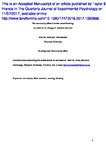The redundancy effect in human causal learning: no evidence for changes in selective attention
| dc.contributor.author | Jones, Peter | |
| dc.contributor.author | Zaksaite, Gintare | |
| dc.date.accessioned | 2017-07-13T08:17:11Z | |
| dc.date.accessioned | 2017-07-13T08:27:00Z | |
| dc.date.issued | 2017-07-11 | |
| dc.identifier.issn | 1747-0218 | |
| dc.identifier.issn | 1747-0226 | |
| dc.identifier.uri | http://hdl.handle.net/10026.1/9616 | |
| dc.description.abstract |
<jats:p> Several recent papers have reported a difference in associative learning for two kinds of redundant cues, such that a blocked cue (e.g., X in A+ AX+) apparently forms a stronger association with the outcome than an uncorrelated cue (e.g., Y in BY+ CY-). This difference is referred to as the redundancy effect, and is of interest because it is contrary to the predictions of a number of popular learning models. One way of reconciling these models with the redundancy effect is to assume that the amount of attention paid to redundant cues changes as a result of experience, and that these changes in attention influence subsequent learning. Here, we present two experiments designed to evaluate this idea, in which we measured overt attention using an eye tracker while participants completed a learning task that elicited the redundancy effect. In both experiments, gaze duration was longer for uncorrelated cues than for blocked cues, but this difference disappeared when we divided gaze durations by trial durations. In Experiment 2, we failed to observe any difference in gaze duration when blocked and uncorrelated cues were subsequently presented together. While the observed difference in gaze duration for the two types of redundant cue may contribute to differences in learning during initial training, we suggest that the principal causes of the redundancy effect are likely to lie elsewhere. </jats:p> | |
| dc.format.extent | 1748-1760 | |
| dc.format.medium | Print-Electronic | |
| dc.language | en | |
| dc.language.iso | en | |
| dc.publisher | SAGE Publications | |
| dc.relation.replaces | http://hdl.handle.net/10026.1/9615 | |
| dc.relation.replaces | 10026.1/9615 | |
| dc.subject | Redundancy effect | |
| dc.subject | attention | |
| dc.subject | learning | |
| dc.subject | blocking | |
| dc.title | The redundancy effect in human causal learning: no evidence for changes in selective attention | |
| dc.type | journal-article | |
| dc.type | Journal Article | |
| plymouth.author-url | https://www.webofscience.com/api/gateway?GWVersion=2&SrcApp=PARTNER_APP&SrcAuth=LinksAMR&KeyUT=WOS:000439361400009&DestLinkType=FullRecord&DestApp=ALL_WOS&UsrCustomerID=11bb513d99f797142bcfeffcc58ea008 | |
| plymouth.issue | 8 | |
| plymouth.volume | 71 | |
| plymouth.publication-status | Published | |
| plymouth.journal | Quarterly Journal of Experimental Psychology | |
| dc.identifier.doi | 10.1080/17470218.2017.1350868 | |
| plymouth.organisational-group | /Plymouth | |
| plymouth.organisational-group | /Plymouth/Faculty of Health | |
| plymouth.organisational-group | /Plymouth/Faculty of Health/School of Psychology | |
| plymouth.organisational-group | /Plymouth/REF 2021 Researchers by UoA | |
| plymouth.organisational-group | /Plymouth/REF 2021 Researchers by UoA/UoA04 Psychology, Psychiatry and Neuroscience | |
| plymouth.organisational-group | /Plymouth/Users by role | |
| plymouth.organisational-group | /Plymouth/Users by role/Academics | |
| dc.publisher.place | England | |
| dcterms.dateAccepted | 2017-06-21 | |
| dc.rights.embargodate | 2018-7-11 | |
| dc.identifier.eissn | 1747-0226 | |
| dc.rights.embargoperiod | 12 months | |
| rioxxterms.versionofrecord | 10.1080/17470218.2017.1350868 | |
| rioxxterms.licenseref.uri | http://www.rioxx.net/licenses/under-embargo-all-rights-reserved | |
| rioxxterms.licenseref.startdate | 2017-07-11 | |
| rioxxterms.type | Journal Article/Review |


